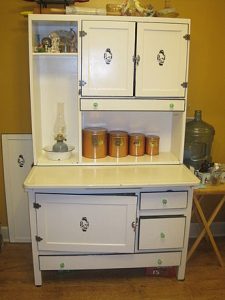Kitchen Cabinets Introduction
Introduction
Kitchen cabinets are the built-in furniture installed in many kitchens for storage of food, cooking equipment, and often silverware and dishes for table service. Appliances such as refrigerators, dishwashers, and ovens are often integrated into kitchen cabinetry. There are many options for cabinets available at present.
History
As commonly used today, the term kitchen cabinet denotes a built-in kitchen installation of either a floor or a wall cabinet. Typically, multiple floor cabinets are covered by a single counter and floors and walls are not accessible behind and under the cabinets. Kitchen cabinets per se were invented in the 20th century. A precursor, not built-in, was the Hoosier cabinet of the 1910s, a single piece of furniture incorporating storage and work surfaces, of which over 2 million were sold by 1920.

A Hoosier cabinet
- Pre-WW-I cabinet design. Typical kitchens before World War I used freestanding work tables and a pantry for dry storage. Cupboards were sometimes used in kitchens, though in larger houses dishes were more typically stored in the dining room or butler’s pantry. Perishable foods such as milk, meat, and vegetables were purchased daily.
- Post-WW-I industrial era. Increasing interest in household efficiency led to pioneering motion studies of housework in the 1920s by industrial psychologist Lillian Moller Gilbreth. Subsequent improvements in kitchen design set the stage for the familiar built-in cabinetry of the present day. At the time, work surfaces were typically made of linoleum or stainless steel. Improvements in technology eventually made industrial-scale cabinet production possible.
- Post-WW-II cabinet design. In the U.S., countertops of high-pressure laminates such as Formica became popular. Laminates led to the adoption of the seamless flush-surface kitchen design that is common today, though laminates themselves began to be supplanted by solid surface materials, such as stone and quartz. In Europe, built-in cabinets had also been pioneered in the 1920s. With improved materials, the frameless cabinet style, notable for its architectural minimalism reminiscent of Bauhaus design, emerged in European kitchen design and was soon adopted worldwide.
- Post-modern cabinet design trends. Other elements of kitchen design affect the choice of cabinetry. For example, post-modern kitchens tend to be characterized by hardwood floors, earth tones, and bare walls in place of wallpaper which, in turn, affect cabinetry choices. Various trends include the introduction of more expensive options, space-saving measures, a larger number of ovens, thicker countertops [2–3 inches (51–76 mm)], taller base cabinets, honed finishes, taller countertop appliances, undercounter and task lighting, and higher [e.g., 9-foot (2.7 m)] ceilings. While these are general kitchen design trends, they have also influenced cabinetry.
- Kitchens today. Modern kitchen design has improved partly as a result of ergonomic research. Functionality is important; one research study had “anthropological scientists” observing homeowners “interact” with their kitchen cabinets. Kitchens are larger and have more cabinets; some kitchens may have as many as fifty drawers and cabinet doors. New features today include deep drawers for cookware, pull-out shelves to avoid excess ben
- ding, sponge trays on the front of sink cabinets, pullout hideaway garbage/recycling containers, pull-out spice cabinets, lazy susans in corner cabinets, vertical storage for cookie sheets, full-extension drawer slides, and drawers and doors with so-called soft-close/positive-close mechanisms enabling drawers to shut quietly, or which shut fully after being pushed only partially. As housing stocks get older, many homeowners face problems with visually unappealing older kitchen cabinets; in such situations, there is a choice to buy new (most expensive), reface existing (less expensive), or to strip and refinish existing (least expensive if done by the homeowner) cabinets. By 2009, there was more emphasis on cabinets designed with environmental factors in mind. So-called “green cabinets” were becoming more popular.As homes in Western countries became

The Frankfurt kitchen of 1926
more airtight to save on heating and cooling costs, air quality has sometimes suffered as gases which are released from resins as they cure. Resins, organic materials which convert from liquid to solid form, are used to manufacture engineered wood (e.g., particleboard) frequently used to build kitchen cabinet carcases can be a factor. According to a recent report: - Considering that North Americans spend a large proportion of their lives indoors, it’s clear why this is a key issue in designing healthy spaces. Additionally, air quality is not a stand-alone problem; rather, every other component of the home can affect air quality. Air quality can be compromised by off-gassing from cabinetry, countertops, flooring, wall coverings or fabrics; by cooking by-products released into the air, and by mold caused by excess moisture or poor ventilation.

